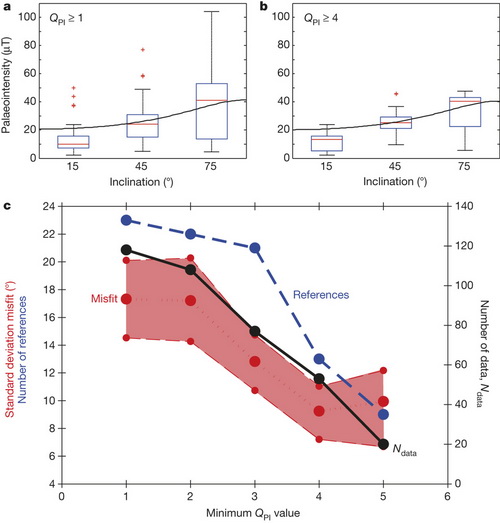The present day inner core of Earth has a solid body of iron (with minor light elements) at its center, which is surrounded by the liquid outer core. The fluid motion within the outer core is responsible for generating Earth's magnetic field. In the past, however, the core was entirely liquid and the timing of when the solid inner core formed is of great debate. Recent studies, using both experimental and numerical methods, have yielded considerably different values for the thermal conductivity of Earth's core, which suggest timing of inner-core nucleation ranging from less than half a billion to nearly two billion years ago.
In collaboration with Associate Professor Greig A. Paterson from the Institute of Geology and Geophysics, Chinese Academy Sciences (IGGCAS), new work, led by Dr Andrew J. Biggin (University of Liverpool) has investigated the strength of the Precambriam geomagnetic field. Using the most up-to-date data, Biggin and co-workers carefully screened the data using newly developed quality criteria (QPI) to ensure that only the best data were used (Biggin & Paterson, 2015, Frontiers Earth Sci., doi: 10.3389/feart.2014.00024). Their analyses of high quality data, confirmed that, much like the present day field, the geomagnetic field between ~500 Ma and ~3.4 Ga is dominantly dipolar (Fig 1).
A temporal analysis of these paleointensity data revealed a distinct high-low-high pattern, with low field strength between ~1.4-2.4 Ga (Fig 2). The surround high periods (0.5-1.3 Ga and 2.4-3.5 Ga), which have median virtual dipole moments (VDMs) of 54 and 44 ZAm2, which are comparable to field intensity over the last 300 Myr (median VDM of 50 ZAm2). Rigorous statistical analyses demonstrate that these are significantly higher than the ~1.4-2.4 Ga low period, which has a median VDM of only 30 ZAm2. This distinct high-low-high pattern of long-term paleointensity variation is consistent with what would be expected as the geodynamo switches from being dominantly powered thermal convection to being predominantly powered by chemical convection. This pattern suggests that Earth's solid inner core began to form about 1-1.5 billion years ago.
These new paleomagnetic results provide strong support for a moderate value for thermal conductivity of Earth's core. This implies that the core is cooling more slowly than previously suggested, which has important implications for the evolution of Earth as a whole.
This new work was recently published in Nature (Link). Biggin, A.J., Piispa, E.J., Pesonen, L.J., Holme, R., Paterson, G.A., Veikkolainen, T., Tauxe, L., 2015. Palaeomagnetic field intensity variations suggest Mesoproterozoic inner-core nucleation. Nature, 526, 245-248, doi: 10.1038/nature15523.

Figure 1. Fits of palaeointensity data by minimum QPI value to palaeomagnetic inclination patterns predicted by a dipole field. a, b, Box-plots for all data in 30° inclination bins with minimum QPI values as shown. Horizontal lines are medians, boxes show the interquartile range (IQR), error bars show the full range excluding outliers (crosses) defined as being more than ±1.5IQR outside the box.

Figure 2. Box-plot and summary statistics for different time intervals comprising VDM estimates with QPI ≥ 3. Ndata refers to the number of VDM estimates in each interval and Nref refers to the number of published studies that these are drawn from. VDMmed and VDMIQR refer, respectively, to the median and interquartile range of the VDM estimates within each interval. See Fig. 1 caption for an explanation of the box plot. Thick error bars indicate 95% confidence limits (from 10,000 bootstraps) on the median values.
Contact:
Greig A. Paterson
Division of the Earth's Deep Structure and Process,IGGCAS
E-mail: greig.paterson@mail.iggcas.ac.cn



